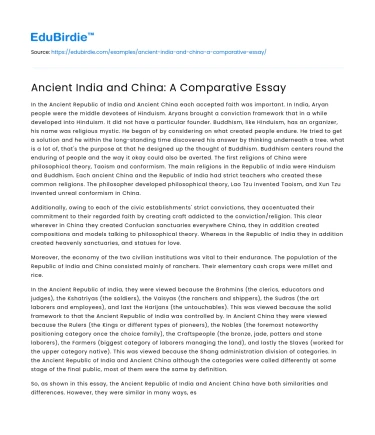In the Ancient Republic of India and Ancient China each accepted faith was important. In India, Aryan people were the middle devotees of Hinduism. Aryans brought a conviction framework that in a while developed into Hinduism. It did not have a particular founder. Buddhism, like Hinduism, has an organizer, his name was religious mystic. He began of by considering on what created people endure. He tried to get a solution and he within the long-standing time discovered his answer by thinking underneath a tree. what is a lot of, that's the purpose at that he designed up the thought of Buddhism. Buddhism centers round the enduring of people and the way it okay could also be averted. The first religions of China were philosophical theory, Taoism and conformism. The main religions in the Republic of India were Hinduism and Buddhism. Each ancient China and the Republic of India had strict teachers who created these common religions. The philosopher developed philosophical theory, Lao Tzu invented Taoism, and Xun Tzu invented unreal conformism in China.
Additionally, owing to each of the civic establishments' strict convictions, they accentuated their commitment to their regarded faith by creating craft addicted to the conviction/religion. This clear wherever in China they created Confucian sanctuaries everywhere China, they in addition created compositions and models talking to philosophical theory. Whereas in the Republic of India they in addition created heavenly sanctuaries, and statues for love.
Save your time!
We can take care of your essay
- Proper editing and formatting
- Free revision, title page, and bibliography
- Flexible prices and money-back guarantee
Moreover, the economy of the two civilian institutions was vital to their endurance. The population of the Republic of India and China consisted mainly of ranchers. Their elementary cash crops were millet and rice.
In the Ancient Republic of India, they were viewed because the Brahmins (the clerics, educators and judges), the Kshatriyas (the soldiers), the Vaisyas (the ranchers and shippers), the Sudras (the art laborers and employees), and last the Harijans (the untouchables). This was viewed because the solid framework to that the Ancient Republic of India was controlled by. In Ancient China they were viewed because the Rulers (the Kings or different types of pioneers), the Nobles (the foremost noteworthy positioning category once the choice family), the Craftspeople (the bronze, jade, potters and stone laborers), the Farmers (biggest category of laborers managing the land), and lastly the Slaves (worked for the upper category native). This was viewed because the Shang administration division of categories. In the Ancient Republic of India and Ancient China although the categories were called differently at some stage of the final public, most of them were the same by definition.
So, as shown in this essay, the Ancient Republic of India and Ancient China have both similarities and differences. However, they were similar in many ways, especially in matters of beliefs.






 Stuck on your essay?
Stuck on your essay?

